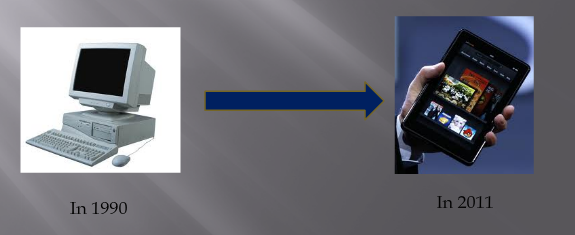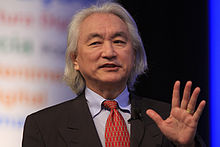Moore's Law
History:
Gordon E. Moore

Picture Source
- The law was named after Intel cofounder Gordon E. Moore
- Moore's Law (published in an article April 19, 1965 in Electronics Magazine).
- Moores Law is a computing term, which originated around the 1970's
- Since the 1970s, the power of computers has doubled every year or and a half, yielding computers which are millions of times more powerful than their ancestors of a half century ago
- The law states that processor speeds, or overall processing power for computers will double about every 18 month's
- Deals with steady rate miniaturization of technology
- Not Really a law
+ More a "Rule of Thumb"
+ A practical way to think about something
- Different computer companies show that the term is not very popular but the rule is still accepted
What is meant by Moore's law ?
- It is specifically stated that the number of transistors on an affordable CPU would double about every 18 month's but more transistors is more accurate according to the prediction of Moore
For Example:
- Moore's Law means ever-more powerful personal computers for less and less money
A computer chip that contained 2,000 transistors and cost $1,000 in 1970, $500 in 1972, $250 in 1974, and $0.97 in 1990 costs less than $0.02 to manufacture today
A personal computer that cost $3,000 in 1990, $1,500 in 1992, and $750 in 1994 would now cost about $5
- The answer is that Moore's Law effectively means that approximately every two years personal computers and other electronic devices can do twice as many new, innovative, and unexpected things than before
- Moore's Law makes it virtually certain that two or four or six or more years from now, we'll be doing more things we didn't expect to do with electronic devices. Some of those things will be absolutely new, without any traditional precedents
- New things. New opportunities. New competitors. Old companies evolving or dying. New companies rising. A changing media landscape. If you think you've seen a lot change so far, you ain't seen nothing yet!
Primary Method:
- The primary method of Moore's observation has been to make wires and transistors that transmit and process information smaller and smaller.
The explosion in computing power comes from an explosion in the size of computing components. The explosion in the size of computing components can't go on forever, given the laws of physics.
Cramming more and more, smaller and smaller, faster and faster components onto computer chips will generate more and more heat. Eventually the chip will melt.
Why does the law exist ?
Some factors that contribute to Moore's Law:
- Manufacturers wishing to keep up with the law
- Competition between manufactures
- Successive technologies providing better design tools
- Customer demand for better products
- Man's constant struggle to advance knowledge
Advancements:
- The contribution of Moore's Law has given rise to the reduction in the robust structure of devices to handy gadgets over these decades
 Picture Source
Picture Source
Growth:
- The capabilities of many digital electronic devices are strongly linked to Moore's law:
- Processing Speed, Memory capacity, sensors, and even the size of pixels in digital cameras
- All of these are improving at (roughly) exponential rates.
- The exponential improvement has dramatically enhanced the impact of digital electronics in nearly every segment of the world economy.
- The exponential growth of Moore's Law will continue beyond the use of integrated circuits into technologies that will lead to technological singularity
The collapse of Moore's Law ?
Picture Source
Michio Kaku (Physicist)

Physicist say its already happening.
Moores law is said to be breaking down, according to theoretical physicist Michio Kaku. He's talking about the so-called law that says the number of transistors that can be fit on a computer chip will double every 18 months, resulting in periodic increases in computing power.
According to Kaku:
"In about ten years or so, we will see the collapse of Moore's law. In fact all ready we see a slowing down of Moore's law. Computer power simply cannot maintain its rapid exponential rise using standard silicon technology". Intel Corporation has admitted this.
Kaku says that when Moore's law finally collapse by the end of the next decade, we will simply tweak it a bit with chip-like computers in three dimensions. He then says "we may have to go to molecular computers and perhaps late in the 21st century quantum computers".
The Future of Moore's Law:
Moore's Own Words:
- "It can't continue forever"
- Eventually miniaturization will lead to atomic level
- At that point the law cannot be sustained
- Still Valid for 10-20 years
Example:
Equation: Pn = Po x 2^n
- Pn = computer processing power in future years
- Po = computer processing power in the beginning year
- n = number of years to develop a new microprocessor divided by 2 (ie. every two years)
Example:
In 1988, the number of transistors in the Intel 386 SX microprocessor was 275,000. What were the transistors counts of the Pentium II Intel microprocessor in 1997 ?
Solution:
If Intel doubles the number of transistors every two years, the new processor would have
Pn = 275,000 x 2^n (where n = 9/2 = 4.5)
= 275,000 x 22.63
= 6.2 million transistors
- In 1997, the Pentium II had 7.5 million transistors. In other words, since 1988 up until 1997 (9 year span), Intel has been doubling the number of transistors in its microprocessors in less than every two years
- The charts below show the number of transistors per chip doubling every 18 months where the transistor count = 1,000. In the years since Moore's Law originated so 1970's into the late 1990's early 2000's

Moore's Law Evolution
 Picture Source
Picture Source
- In the 1970's there were around 1000 transistors placed in a integrated chip
Transistor Count (1971-2012)
Where we are today

- Today there are over 3 billion transistors that are placed in a chip and still the researches are going on to increase that number
What's Next For Computers ?
A few possiblitites are:
- Molecular transistors
- Or further down the road, quantum computers
- Until then, Intel, AMD, and other chip makers will continue to squeeze every last ounce of speed and power they can from silicon designs.






